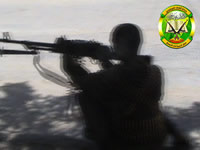|
|
|
Image of a Shabaab fighter from the terror group’s website. |
The two main Islamist terror groups battling the weak Somali government may merge into a single outfit.
Sheikh Hassan Dahir Aweys, the leader of Hizbul Islam or the Party of Islam, said he is working to unite his faction with Shabaab, an al Qaeda-backed Islamic terror group that has lobbied to join the international terrorist organization. Aweys said talks were proceeding and urged followers to continue to fight until they achieve “victory over enemies” of Islam.
Aweys, who is an al Qaeda ally and a designated terrorist, made the announcement in front of a large crown of worshipers in front of the Aba Hureyra Mosque in Bakaraha market in Mogadishu, according to a report in Maareg.
Shabaab, or the Somali Youth Movement, is led by Ahmed Abdi Aw Mohamed, the reclusive spiritual leader who was seriously wounded in an explosion at a Mogadishu safehouse on May 17.
Hizbul Islam was created in January of this year with the merger of four separate Islamic groups: Aweys’ Alliance for the Re-Liberation of Somalia-Eritrea; Mu’askar Ras Kamboni (the Ras Kamboni Brigade); Jabhatul Islamiya (the Islamic Front); and Anole. Hizbul Islam was formerly led by Sheik Omar Iman Abu Bakar but was ousted by Aweys earlier this for being too moderate.
The Ras Kamboni Brigade is a radical Islamist group that was founded by Sheikh Hassan Turki, a former senior leader in the Islamic Courts and its predecessor, al Itihaad al Islamiyah. Turki operates terrorist training camps in southern Somalia and was likely the target of a US airstrike in March 2008.
In late February Hizbul Islam joined forces with Shahaab in the battle with the African Union peacekeepers that left nearly 50 dead and 300 wounded. The two groups have been relentless in attacking Somali government forces and the African Union peacekeepers stations in the capital.
Outside of Mogadishu, the central government wields little control. Shabaab and Hizbul Islam currently control all of the southern and many of the central provinces of Lower Jubba, Middle Jubba, Lower Shabelle, Gedo, Bay, and Bakool, as well as much of Mogadishu, where the government only controls a few enclaves. Aweys’ very public speech in the Bakaraha market indicates government forces cannot project power beyond the few bases and the presidential palace in the capital.
The central Somali districts of Middle Shabelle, Hiran, and Galgadud are considered contested, with the government and allied Islamist groups in nominal control of some areas.
Not only do Shabaab and Hizbul Islam reject the African Union presence in Somalia, the groups also reject President Sharif and his faction of the Alliance for the Re-Liberation of Somalia – Djibouti for reconciling with the Somali government. Sharif was the co-leader of the now-defunct Islamic Courts Union with Aweys in 2006 until the Ethiopian invasion ousted the movement in early 2007.
A merger would increase al Qaeda’s influence in the Horn of Africa
A merger between Shabaab and Hizbul Islam would smooth over any command and control problems between the two groups and expand al Qaeda’s influence in the Somali jihad.
One recent point of contention between the two groups occurred immediately after the capture of two French security officials by Hizbul Islam fighters at a hotel in Mogadishu. Shabaab and Hizbul Islam almost came to blows after Shabaab demanded the prisoners be handed to them. Aweys eventually relented, saying he handed the French officials to Somalia to avoid a “war” between the groups.
Al Qaeda has consistently backed the jihad front in Somalia through funding, personnel, and weapons. The union of Shabaab and Hizbul Islam would give the latter better access to resources from the global terror network.
Al Qaeda has increasingly focused on Somalia as being a major theater in their efforts to drive the West from Africa, the Middle East, and Asia. Osama bin Laden and Ayman al Zawahiri, al Qaeda’s second in command, have included Somalia in their propaganda tapes. Both leaders have urged Somali terrorist to continue the fight.
In February of this year, Zawahiri released a videotape congratulating Shabaab for the capture of southern Somalia. He also stated the importance of capturing particular regions in the country, specifically Baidoa.
In September of 2008 Shabaab formally reached out to al Qaeda senior leadership in an effort to better integrate with the network and its strategic nodes across Africa and the Middle East. The effort came in the form of a 24-minute video that features Kenyan al Qaeda operative Saleh Ali Saleh Nabhan, who is wanted by the US Government for his involvement in the 1998 African embassy attacks and 2002 Mombasa attacks. Shabaab is formally seeking to join al Qaeda.
Shabaab’s offer to officially join al Qaeda was warmly received by bin Laden and Zawahiri. The two groups have yet to merge but maintain close operational and financial ties.








